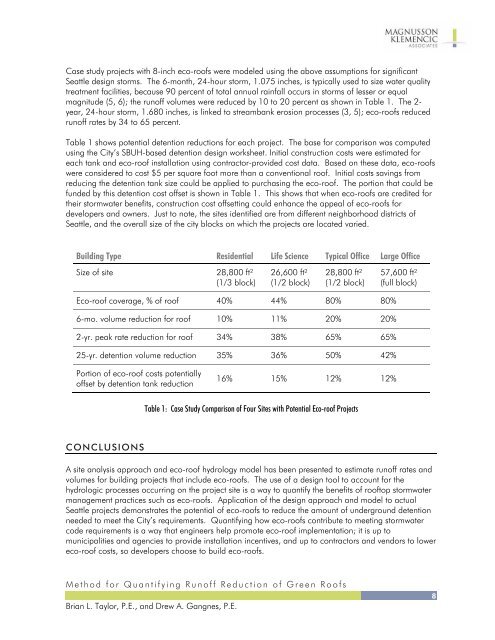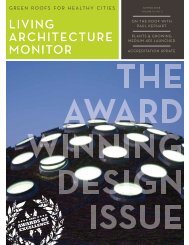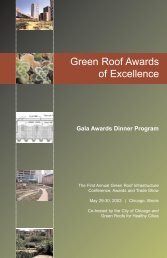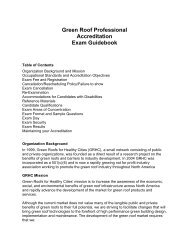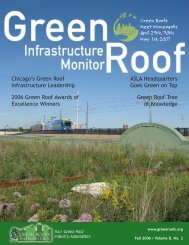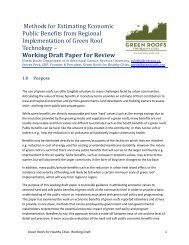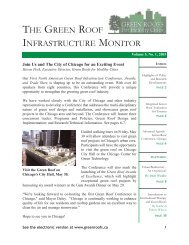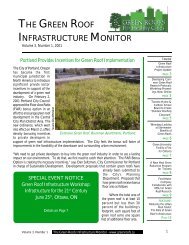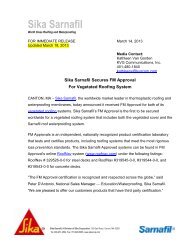Brian L. Taylor, P.E., and Drew A. Gangnes, P.E. - Green Roofs for ...
Brian L. Taylor, P.E., and Drew A. Gangnes, P.E. - Green Roofs for ...
Brian L. Taylor, P.E., and Drew A. Gangnes, P.E. - Green Roofs for ...
- No tags were found...
Create successful ePaper yourself
Turn your PDF publications into a flip-book with our unique Google optimized e-Paper software.
Case study projects with 8-inch eco-roofs were modeled using the above assumptions <strong>for</strong> significantSeattle design storms. The 6-month, 24-hour storm, 1.075 inches, is typically used to size water qualitytreatment facilities, because 90 percent of total annual rainfall occurs in storms of lesser or equalmagnitude (5, 6); the runoff volumes were reduced by 10 to 20 percent as shown in Table 1. The 2-year, 24-hour storm, 1.680 inches, is linked to streambank erosion processes (3, 5); eco-roofs reducedrunoff rates by 34 to 65 percent.Table 1 shows potential detention reductions <strong>for</strong> each project. The base <strong>for</strong> comparison was computedusing the City’s SBUH-based detention design worksheet. Initial construction costs were estimated <strong>for</strong>each tank <strong>and</strong> eco-roof installation using contractor-provided cost data. Based on these data, eco-roofswere considered to cost $5 per square foot more than a conventional roof. Initial costs savings fromreducing the detention tank size could be applied to purchasing the eco-roof. The portion that could befunded by this detention cost offset is shown in Table 1. This shows that when eco-roofs are credited <strong>for</strong>their stormwater benefits, construction cost offsetting could enhance the appeal of eco-roofs <strong>for</strong>developers <strong>and</strong> owners. Just to note, the sites identified are from different neighborhood districts ofSeattle, <strong>and</strong> the overall size of the city blocks on which the projects are located varied.Building Type Residential Life Science Typical Office Large OfficeSize of site28,800 ft²(1/3 block)26,600 ft²(1/2 block)28,800 ft²(1/2 block)57,600 ft²(full block)Eco-roof coverage, % of roof 40% 44% 80% 80%6-mo. volume reduction <strong>for</strong> roof 10% 11% 20% 20%2-yr. peak rate reduction <strong>for</strong> roof 34% 38% 65% 65%25-yr. detention volume reduction 35% 36% 50% 42%Portion of eco-roof costs potentiallyoffset by detention tank reduction16% 15% 12% 12%Table 1: Case Study Comparison of Four Sites with Potential Eco-roof ProjectsCONCLUSIONSA site analysis approach <strong>and</strong> eco-roof hydrology model has been presented to estimate runoff rates <strong>and</strong>volumes <strong>for</strong> building projects that include eco-roofs. The use of a design tool to account <strong>for</strong> thehydrologic processes occurring on the project site is a way to quantify the benefits of rooftop stormwatermanagement practices such as eco-roofs. Application of the design approach <strong>and</strong> model to actualSeattle projects demonstrates the potential of eco-roofs to reduce the amount of underground detentionneeded to meet the City’s requirements. Quantifying how eco-roofs contribute to meeting stormwatercode requirements is a way that engineers help promote eco-roof implementation; it is up tomunicipalities <strong>and</strong> agencies to provide installation incentives, <strong>and</strong> up to contractors <strong>and</strong> vendors to lowereco-roof costs, so developers choose to build eco-roofs.Method <strong>for</strong> Quantifying Runoff Reduction of <strong>Green</strong> <strong>Roofs</strong><strong>Brian</strong> L. <strong>Taylor</strong>, P.E., <strong>and</strong> <strong>Drew</strong> A. <strong>Gangnes</strong>, P.E.8


